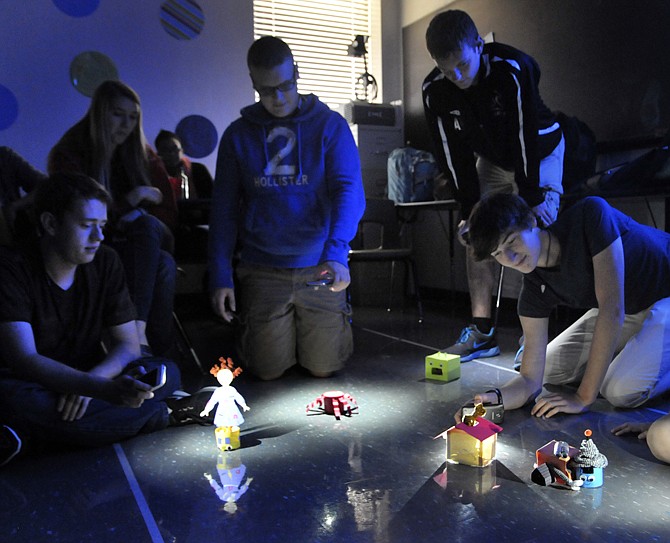In the darkened classroom the students knelt on the floor in a small circle. In their midst, a scattering of small machines jittered to and fro.
The project was an opportunity for the teenagers, who built the robots from kits, to test some of the ideas they'd learned in their Calculus II class this fall.
The concept - using narrow beams of light to direct the robots - was simple. The math lesson - to better understand differential equations and slope fields - was less so.
By assigning the project, their teacher Jana Forck was looking for a way to tie into her lesson plan a few electrical engineering concepts.
"I have several students who will someday be engineers," Forck said.
After dividing her 31 Jefferson City High School students into smaller groups, each team was given an electronic "breadboard," a few resistors, a battery pack, a switch, two motors and a couple of toothbrush heads, which provided the necessary friction for the "feet" to move.
From those elements, each group created their own robot and outfitted it with small costume.
Charlie Winborn's team patterned their little guy after Wall-E, the lonely waste-collecting robot who found love after a trek across the universe. The other teams' robots were disguised as Shrek, a cupcake, a giraffe, an owl and Mrs. Frizzle and the Magic School Bus.
Each of the tiny machines was equipped with a couple of photo resistors. By using the bright beams from their cell phones they were able to either entice the machine to follow the light or turn away from it.
"It took some trial and error," Forck added. "They had to troubleshoot ... double-check the connections and angle the light-sensors ... because they all didn't work right the first time."
To complete the task, Winborn and his peers had to use their knowledge from previous assignments to complete the electrical circuit.
He said it was "fun to apply calculus to electrical engineering and see your math at work."
When finished, the robots were not unlike the tiny Hexbugs popular with small children. "Well, that's one of the practical applications - toys," Wilborn said.
Kayla Smith, 17, plans to study engineering at college next year, probably at the University of Oklahoma.
She said it took some practice to get the tiny machines to function properly. "I thought it was really exciting," she said.
Both teens said the task was an amusing break from their normal math-class routine.
"It was different from our normal book work," Smith said.
"It was a nice change," Winborn added. "Ms. Forck uses a lot of examples that make it lively. I'm very glad I got her for calculus."

